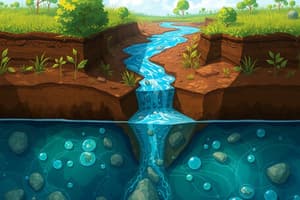Podcast
Questions and Answers
How does permeability influence water flow through soil, and why is this important in geotechnical engineering?
How does permeability influence water flow through soil, and why is this important in geotechnical engineering?
Permeability determines how easily water flows through soil. It's important for foundation design, slope stability analysis, and the construction of earth dams and tunnels.
Explain the difference between 'permeability' and 'hydraulic conductivity'.
Explain the difference between 'permeability' and 'hydraulic conductivity'.
Permeability is a measure of a soil's ability to allow fluids to pass through it and is an intrinsic property of the soil/rock. Hydraulic conductivity measures the ease with which water flows through soil, considering both soil and fluid properties.
Describe the pore water pressure conditions at and below the water table.
Describe the pore water pressure conditions at and below the water table.
At the water table, pore water pressure (u) is equal to 0. Below the water table, pore water pressure increases with depth.
How does a 'steady-state seepage condition' differ from a 'hydrostatic condition' in soils?
How does a 'steady-state seepage condition' differ from a 'hydrostatic condition' in soils?
Explain the implications of a 'transient seepage condition' on the effective stress within a soil mass.
Explain the implications of a 'transient seepage condition' on the effective stress within a soil mass.
In the context of fluid flow within soils, what is implied by the term 'steady-state'?
In the context of fluid flow within soils, what is implied by the term 'steady-state'?
Darcy's Law is predicated on a certain type of flow. What type of flow and why is it important?
Darcy's Law is predicated on a certain type of flow. What type of flow and why is it important?
Explain the difference between average velocity and seepage velocity in the context of water flow through soil.
Explain the difference between average velocity and seepage velocity in the context of water flow through soil.
Describe how the double layer of water in fine-grained soils affects hydraulic conductivity.
Describe how the double layer of water in fine-grained soils affects hydraulic conductivity.
How does the presence of entrapped gases affect the hydraulic conductivity of soil?
How does the presence of entrapped gases affect the hydraulic conductivity of soil?
How do layering and fissures in soil affect water seepage, and why are they a concern in geotechnical engineering?
How do layering and fissures in soil affect water seepage, and why are they a concern in geotechnical engineering?
In a constant-head permeability test, what parameters are measured, and how are they used to determine hydraulic conductivity?
In a constant-head permeability test, what parameters are measured, and how are they used to determine hydraulic conductivity?
Explain the key difference between the constant-head test and the falling-head test for determining hydraulic conductivity.
Explain the key difference between the constant-head test and the falling-head test for determining hydraulic conductivity.
What measurements are taken during a falling-head permeability test, and how is hydraulic conductivity calculated from them?
What measurements are taken during a falling-head permeability test, and how is hydraulic conductivity calculated from them?
Describe a practical application of calculating the equivalent hydraulic conductivity in stratified soils.
Describe a practical application of calculating the equivalent hydraulic conductivity in stratified soils.
In the formula $k = 2.303 \frac{aL}{At} log_{10} \frac{h_1}{h_2}$ used in the falling head test, what does each variable refer to?
In the formula $k = 2.303 \frac{aL}{At} log_{10} \frac{h_1}{h_2}$ used in the falling head test, what does each variable refer to?
What does the variable 'i' stand for in Darcy's Law and describe how it's caculated.
What does the variable 'i' stand for in Darcy's Law and describe how it's caculated.
How does the void ratio of a soil relate to its hydraulic conductivity, and why is this relationship important?
How does the void ratio of a soil relate to its hydraulic conductivity, and why is this relationship important?
According to Fancher et al. (1933), what inequality must be satisfied for Darcy's Law to be applicable for determining hydraulic conductivity?
According to Fancher et al. (1933), what inequality must be satisfied for Darcy's Law to be applicable for determining hydraulic conductivity?
List four factors that influence the hydraulic conductivity of soils.
List four factors that influence the hydraulic conductivity of soils.
Flashcards
Permeability
Permeability
Describes how easily water flows through soil.
Seepage
Seepage
Refers to the movement of water through soil due to hydraulic gradients.
Groundwater
Groundwater
Water under gravity that fills the soil pores.
Head (H)
Head (H)
Signup and view all the flashcards
Hydraulic conductivity
Hydraulic conductivity
Signup and view all the flashcards
Permeability (Intrinsic)
Permeability (Intrinsic)
Signup and view all the flashcards
Hydraulic Conductivity
Hydraulic Conductivity
Signup and view all the flashcards
Pore water pressure (u)
Pore water pressure (u)
Signup and view all the flashcards
Effective stress
Effective stress
Signup and view all the flashcards
Hydrostatic condition
Hydrostatic condition
Signup and view all the flashcards
Steady-state seepage condition
Steady-state seepage condition
Signup and view all the flashcards
Transient seepage condition
Transient seepage condition
Signup and view all the flashcards
Darcy's Law
Darcy's Law
Signup and view all the flashcards
Average Velocity
Average Velocity
Signup and view all the flashcards
Seepage Velocity
Seepage Velocity
Signup and view all the flashcards
Pore size
Pore size
Signup and view all the flashcards
Entrapped gases
Entrapped gases
Signup and view all the flashcards
Darcy's Law
Darcy's Law
Signup and view all the flashcards
Study Notes
- Module 6 covers permeability and seepage in soil mechanics.
- Learning outcomes include discussing methods for determining the coefficient of permeability, determining the rate of water flow through soils, and understanding seepage and flow nets to solve related problems.
Introduction
- Permeability dictates the ease with which water flows through soil.
- Seepage is the movement of water through soil due to hydraulic gradients.
- Applications of permeability and seepage knowledge include foundation design, slope stability analysis, and the construction of earth dams and tunnels.
Definition of Terms
- Groundwater fills soil pores under gravity.
- Head (H) is the mechanical energy per unit weight in soil.
- Hydraulic conductivity (k), or coefficient of permeability, is a constant that relates to the velocity of water flow through soils.
- Permeability reflects a soil's ability to allow the passage of fluids, an intrinsic property independent of fluid type.
- Hydraulic conductivity is a material-fluid-dependent property, influenced by both soil structure and water characteristics, and reflects the measure of ease for water flow.
- Pore water pressure (u) is the pressure exerted by water within soil pores; it equals zero at the water table and acts equally in all directions.
- Effective stress is the total stress minus the pore water pressure.
- Hydrostatic condition occurs when pore water pressure is constant over time and the water table is level, indicating no flow.
- Steady-state seepage condition assumes stationary soil particles, with the amount of flow constant over time, the water table is not level and the hydraulic gradient causes steady-state seepage flow.
- Transient seepage condition: Changes in effective stress result in soil deformation, and both pore water pressure and flow rate vary with time; the water table is not level.
Head and Pressure Variation in a Fluid at Rest
- Steady-state exists when water flow rate and direction remain constant at every mass point over time.
- Hydraulic head and gradient remain constant at any soil location in steady-state.
- This assumes steady and inviscid flow, incompressible, and irrotational fluid particles.
Darcy's Law
- Average flow velocity through soils is proportional to the total head gradient
- The flow in any direction, j:
- Vj = kj * (dH/dxj)
- where:
- v is the average flow velocity
- k is the hydraulic conductivity coefficient
- dH change in total head
- dx is distance
- The unit of measurement for k is length/time (cm/s).
- Darcy's law equation: Vx = kx * (ΔH/L) = kx * i
- i = ΔH/L (hydraulic gradient).
- Darcy's law applies when flow is laminar.
- In most soils, flow is slow, it is considered laminar.
- Head loss increases linearly with velocity in laminar flow.
- Exceeding the transition zone initiates internal eddy currents and mixing, leading to a nonlinear relationship as energy dissipates at a greater rate.
Average Velocity
- Average velocity (v) is a macroscopic concept representing the apparent velocity of water flowing through a unit cross-sectional area of bulk soil.
- Imagine a pipe filled with soil: average velocity is the total water flow rate divided by the pipe's total cross-sectional area.
- Water flows through interconnected pore spaces, so the actual velocity of water molecules within these pores is greater than the average velocity.
Seepage Velocity
- Seepage velocity (vs) represents the actual average velocity of water flowing through interconnected pore spaces.
- It considers that water moves through a portion of the total cross-sectional area.
Soil Factors Affecting Hydraulic Conductivity
- Coarse-grained soils have higher hydraulic conductivities than fine-grained soils due to the water in the double layer reducing the seepage pore space.
- Hydraulic conductivity depends on D10 for coarse soils.
- Pore fluid properties, specifically viscosity: k₁/k₂ ≈ μ₂/μ₁, where is dynamic viscosity.
- Void ratio: k₁/k₂ ≈ e₁/e₂ for coarse grains.
- Pore size: Higher interconnected pore space results in higher hydraulic conductivity, related to the square of the pore size.
- Water tends to seep quickly through loose layers and fissures.
- Catastrophic failures can occur from seepage.
- Entrapped gases reduce conductivity, and are difficult to get rid of.
- Darcy's law is valid only for laminar flow (Reynolds number < 2100).
- Fancher et al. (1933) gave the following criterion for Darcy's Law: (vDρw)/µ ≤ 1
Other Factors Affecting Hydraulic Conductivity
- Fluid viscosity, pore and grain-size distribution, roughness and degree of saturation are factors.
- In clayey soils, structure plays an important role in hydraulic conductivity.
- The ionic concentration and the thickness of layers of water held to clay particles affect the permeability of clays.
Constant-Head Test
- The water supply is adjusted so that the head difference is constant during the test period
- Water is collected in a graduated flask for a duration once a constant flow rate is achieved.
- Q = Avt = A(ki)t
- Q is the volume of water
- A is the cross-sectional area
- t is the collection time
- i = h/L
- h is the head difference
- L, the specimen length
- Hydraulic conductivity is then k = (QL)/(Aht)
- where Q is voume of water collected, A is the cross sectional area of the specimen, t is duration and h is the head
Falling-Head Test
- The method consists of water from a standpipe, flowing through a soil specimen.
- The initial head difference, h1 at time t = 0, and the final head difference, h2 at time t = t2, are recorded
- The rate of flow: q = k(A/L)h = -a(dh/dt)
- To find conductivity, use, k = 2.303*(aL/At)*log10(h1/h2), with:
- k = hydraulic conductivity
- a = cross-sectional area of the standpipe
- A is the cross-sectional area of the soil specimen
- L is the length
- t is time
Illustrative Problem 1
- Thickness of permeable soil layer = 1.1 m, angle = 15°, K = 3.75x10-2 cm/sec, e = 0.6
- Calculate:
- Hydraulic gradient
- Flow rate (cu.m/hr/m)
- Seepage velocity
Calculating Flow Parameters
- Soil sample is 10 cm in diameter, 1 m long.
- 1 cm3 of water is collected every 10 seconds.
- Determine:
- Hydraulic gradient
- Flow rate
- Average velocity
- Seepage velocity
- Hydraulic conductivity
Illustrative Problem 2
- Constant-head test, where:
- L = 30 cm
- A = 177 cm²
- h = 50 cm
- Water collected = 350 cm³ in 5 minutes.
- Find hydraulic conductivity (cm/sec).
Illustrative Problem 3
- For a falling-head permeability test
- Length = 8 in.
- Soil area = 1.6 in²
- Standpipe area = 0.06 in²
- Head difference at t=0 = 20 in.
- Head difference at t=180 sec = 12 in.
- Determine hydraulic conductivity (in/sec).
Equivalent Hydraulic Conductivity in Stratified Soils
- Consider a unit length cross-section passing through the n layer and perpendicular to flow direction.
- Total flow through the cross-section in unit time:
- q = v * 1 * H
- where: - v = average discharge velocity - v₁, v₂, v₃, ..., vₙ are discharge velocities of flow in layers
- Let's say that kH₁, kH₂, kH₃,..., kHₙ are the hydraulic conductivities of the individual layers in the horizontal direction and kH(eq) is the equivalent hydraulic conductivity in the horizontal direction
- From Darcy's law: v = kH(eq)*ieq; v₁ = kH₁ i₁; v₂ = kH₂ i₂; v₃ = kH₃ i₃; ... vₙ = kHₙ in
Studying That Suits You
Use AI to generate personalized quizzes and flashcards to suit your learning preferences.




